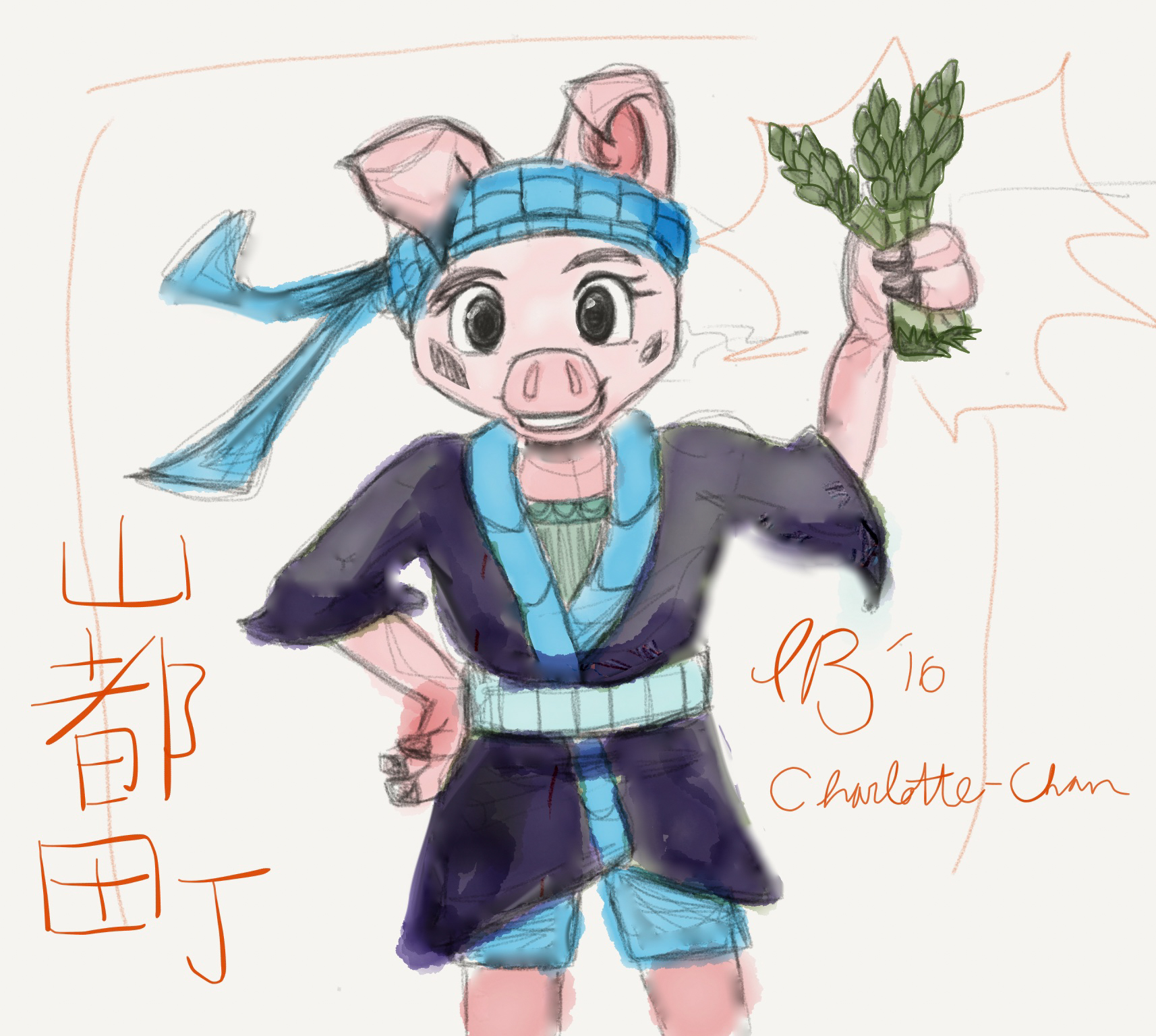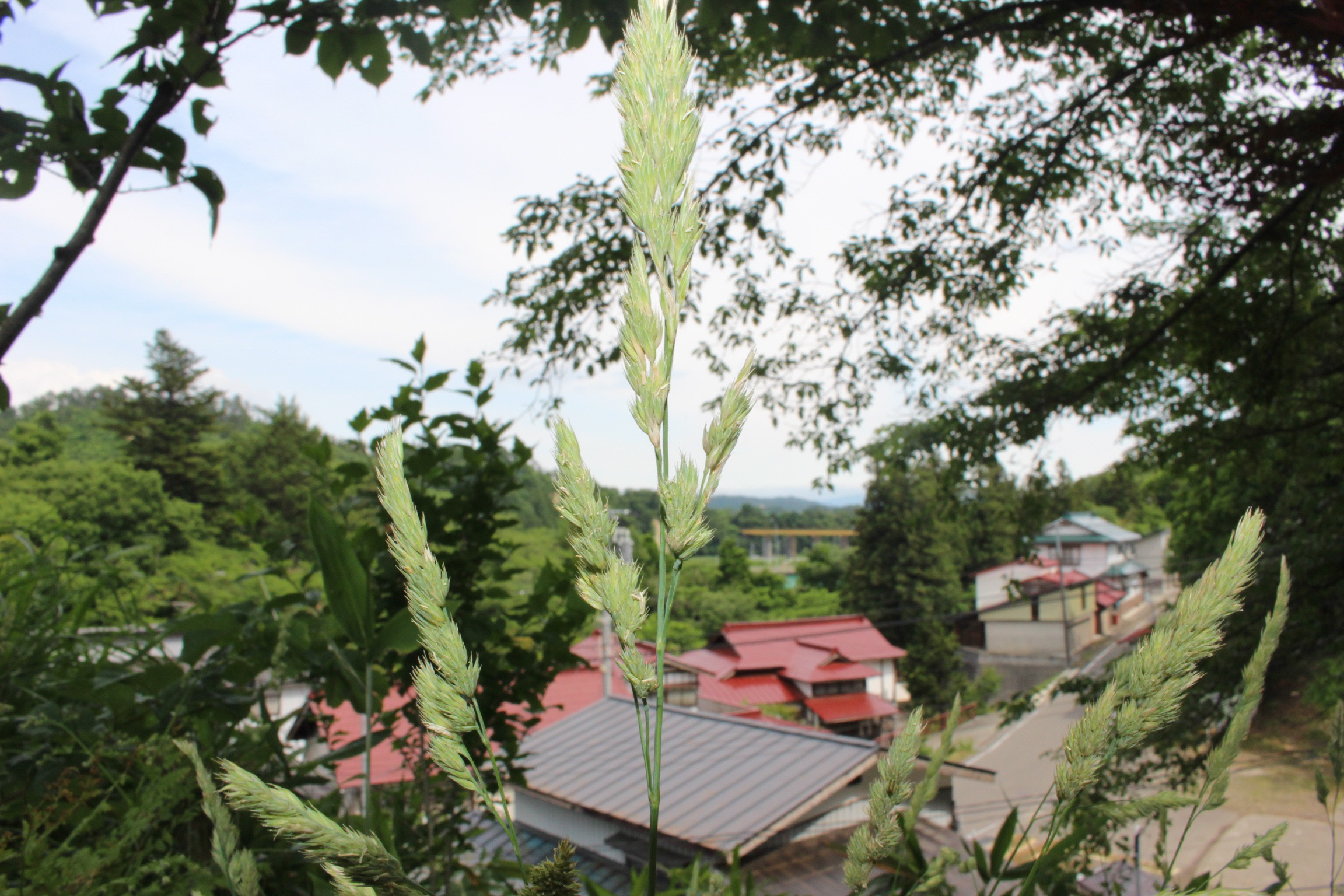Greater Kitakata Area:
Enjoy five distinct environments across the mountains, plains and valleys, each with their own local specialties and history
Five towns consolidated in 2006 comprise today’s Kitakata City. Each area maintains distinct features and activities. Visit each one for a different natural setting, experience and adventure. Learn more about Kitakata’s history in the interactive timeline below.

Yum! Like the other Yamato pigs, Charlotte-chan especially loves eating her asparagus!
Kitakata City & Its Four Towns
Central Kitakata City expanded to include four neighboring towns in 2006.
Atsushiokano Area
~ Visit Yamagataya and relax in the historic waters of Atsushio and in Japan’s first low-temperature charcoal sauna. Find more details here and make a reservation today on Jalan! Yamagataya Information and Booking
~ Check out Himesayuri-no-oka. Beautiful blossoming rosy lilies(himeyasuri) are rare even in Japan. Enjoy expansive views of these rare flowers at their best in early June.
~ Take to the slopes at Sannokura, a ski resort overlooking the Aizu basin. You can find some more information about how to get to Sannokura here, as well as more about the slopes. Sannokura Ski and Snowboard Information
Besides featuring slopes great for intermediate and beginner skiers, Sannokura is covered nearly 2 million bright flowers each summer, making it the largest flower field in all of Tohoku, at about 20 acres of blazing sunflowers and cosmos. See photos and more information about this beautiful sea of flowers. Their warm colors extend as far as the eye can see. Sannokura Flower Field Pictures and Information
~ The Nitchu Railway had more than 90 years of history. Local residents pressed for a national railway to be constructed, and the Nitchu Railway closed in 1984. Three years later, a memorial hall was opened featuring relics from when the line was still in operation such as old train cars.
Shiokawa Area
~ Visit the Shiokawa Commercial Museum Kawabansho to purchase charming local products. Displays showcase local goods and and visitors can purchase souvenirs. Main products include Inoue Kokeshi Dolls, soy sauce, textile products, miso and miso preserves. Tel. (0241)27-8691
~ Gotemba Park features gorgeous cherry blossoms from mid-to late April and Japanese Irises from mid-to late June. The park is a resort area for successive members of the Aizu clan. You can enjoy the park year round, but it is especially renowned in spring for its 200 cherry trees, in summer for its 36,000 iris plants of 60(!) different types, and in fall for beautiful autumn foliage.
~ See history at a city designated historical site, Banjo-go-hara. In 1882, citizens protested against the “Aizu Three Roads Excavation Plan” Prefectural Ordinance set in place by Michitsune Mishima. This ordinance ignored the rights of citizens, so well over 1,000 citizens collected to form a democratic rights movement. They demanded justice, the right to speak, and freedom from oppression.
~ A prefectural designated historical site, the Beppu Milestone is located along the Yonezawa Kaito road, which was one of the Aizu Gokaido Roads. Milestones were established in the Edo period to be a guide for transportation. This relic is largely unchanged in shape, so it is a valuable historic relic.
Takasato Area
Takasato area features two distinctive outdoor experiences.
~ Play archaeologist for the day as you try digging up fossils of bivalves, snails, and mammals. The Fossil Excavation Experience allows visitors to partake in a two hour session lead by Aizu Fossil Research Group Members. Tel. (0241)44-2024
~ See the Japanese “knuckle four” configuration in the Boat Experience which is rowing with one coxswain and four rowers. Under the guidance of a local coach, you will row around a 6 different 1,000 m, B-grade approved courses. Groups should apply with three people or more. There are 6 available boats, so a total of 30 people can participate at one time. The instructors are NPO Aizu Tosokai members. This activity costs 700 yen and the guided experience will take place on the “Ogino Boat Course.”
Yamato Area

Yamato features delicious soba, spectacular nature spots, mountain trails ready for adventure, and of course a beautiful onsen to relax in after a hard day’s work.
~ Yamato’s soba noodles are incredibly fresh and delicious thanks to the ideal environment and temperatures Yamato’s buckwheat grows in. See why Yamato residents are very proud of their soba by trying some at a local restaurant! Or, try making your own! Besides fresh soba, Yamato has delicious organic produce, such as asparagus, that visitors will not want to miss. Kitakata is Tohoku’s number one producer of asparagus! You can buy some of these fresh, tasty foods at the local farmers market. Check out the food experience page for more on the farmers market.
~ Yamato’s name, “Mountain capital” is very illustrative of the town’s landscape. Towering Mt. Iide has a peak of 2,150 meters in Yamato. There is a historical pilgrimage up this mountain that, when successfully completed, has symbolized gaining strength, maturity, becoming an adult, and being reborn. Check out the hiking page for recommendations on you own hiking experience and what might be good to do.
~Iide no yu onsen features guest rooms to stay overnight in as well as towel services, an indoor bath and a rotenburo (a Japanese outdoor hot spring). Soak your stress away in the crystal clear waters from the mountain!
~ Numanodaira Adonis Fields have an annual 1 million Adonis ramosa blooming, making it one of Japan’s largest Adonis fields. Peak viewing times are from late March to early April.
Kitakata’s rich history
Explore the area’s history in this interactive timeline! Click the events to learn more.